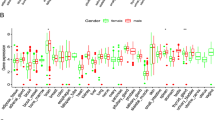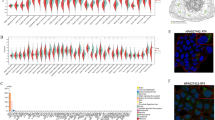Abstract
Novel molecular markers for cancer progression are valuable for the diagnosis and evaluation of treatment efficacies of the diseases. Expression of inosine 5′-monophosphate dehydrogenase type II (IMPDH2), a rate-limiting enzyme in the de novo guanine nucleotide biosynthesis, is up-regulated in various neoplasms, including prostate cancer and patient serum. However, whether IMPDH2 can serve as a biomarker for other urologic cancers is unknown. Paired patient tissue macroarrays were analyzed by immunohistochemistry, the IMPDH2 protein expression in these tissues was quantitated and expressed as immunoreactivity scores. Compared with non-cancerous tissues, IMPDH2 protein expression levels were significantly upregulated in kidney and bladder cancer, but no difference in testis cancer. In addition, expression of IMPDH2 was not associated with the disease clinical stages and pathological features. The findings suggest that overexpressed IMPDH2 can be used as a biomarker for kidney and bladder cancer diagnosis and is a potential therapeutic target for the diseases.



Similar content being viewed by others
References
Bairagya HR, Mukhopadhyay BP, Sekar K. An insight to the dynamics of conserved water molecular triad in IMPDH II (human): recognition of cofactor and substrate to catalytic Arg 322. J Biomol Struct Dyn. 2009;27(2):149–58.
Chen L, Petrelli R, Gao G, et al. Dual inhibitors of inosine monophosphate dehydrogenase and histone deacetylase based on a cinnamic hydroxamic acid core structure. Bioorg Med Chem. 2010;18(16):5950–64.
Bowne SJ, Sullivan LS, Mortimer SE, et al. Spectrum and frequency of mutations in IMPDH1 associated with autosomal dominant retinitis pigmentosa and leber congenital amaurosis. Invest Ophthalmol Vis Sci. 2006;47(1):34–42.
Floryk D, Tollaksen SL, Giometti CS, Huberman E. Differentiation of human prostate cancer PC-3 cells induced by inhibitors of inosine 5′-monophosphate dehydrogenase. Cancer Res. 2004;64(24):9049–56.
Thomas EC, Gunter JH, Webster JA, et al. Different characteristics and nucleotide binding properties of inosine monophosphate dehydrogenase (IMPDH) isoforms. PLoS One. 2012;7(12):e51096.
Han ZD, Zhang YQ, He HC, et al. Identification of novel serological tumor markers for human prostate cancer using integrative transcriptome and proteome analysis. Med Oncol. 2012;29(4):2877–88.
Zhou L, Xia D, Zhu J, et al. Enhanced expression of IMPDH2 promotes metastasis and advanced tumor progression in patients with prostate cancer. Clin Transl Oncol. 2014;16(10):906–13.
Vethe NT, Bremer S, Bergan S. IMP dehydrogenase basal activity in MOLT-4 human leukaemia cells is altered by mycophenolic acid and 6-thioguanosine. Scand J Clin Lab Invest. 2008;68(4):277–85.
He Y, Mou Z, Li W, et al. Identification of IMPDH2 as a tumor-associated antigen in colorectal cancer using immunoproteomics analysis. Int J Colorectal Dis. 2009;24(11):1271–9.
Fellenberg J, Bernd L, Delling G, Witte D, Zahlten-Hinguranage A. Prognostic significance of drug-regulated genes in high-grade osteosarcoma. Mod Pathol. 2007;20(10):1085–94.
Li M, Su BS, Chang LH, et al. Oxymatrine induces apoptosis in human cervical cancer cells through guanine nucleotide depletion. Anticancer Drugs. 2014;25(2):161–73.
He HC, Ling XH, Zhu JG, et al. Down-regulation of the ErbB3 binding protein 1 in human bladder cancer promotes tumor progression and cell proliferation. Mol Biol Rep. 2013;40(5):3799–805.
Zhang Z, Zhang G, Kong C. High expression of polo-like kinase 1 is associated with the metastasis and recurrence in urothelial carcinoma of bladder. Urol Oncol. 2013;31(7):1222–30.
Soskine M, Tawfik DS. Mutational effects and the evolution of new protein functions. Nat Rev Genet. 2010;11(8):572–82.
Anantharaman V, Aravind L, Koonin EV. Emergence of diverse biochemical activities in evolutionarily conserved structural scaffolds of proteins. Curr Opin Chem Biol. 2003;7(1):12–20.
Hedstrom L. IMP dehydrogenase: structure, mechanism, and inhibition. Chem Rev. 2009;109(7):2903–28.
Morrison HG, McArthur AG, Gillin FD, et al. Genomic minimalism in the early diverging intestinal parasite Giardia lamblia. Science. 2007;317(5846):1921–6.
Carlton JM, Hirt RP, Silva JC, et al. Draft genome sequence of the sexually transmitted pathogen Trichomonas vaginalis. Science. 2007;315(5809):207–12.
Ma W, Diep K, Fritsche HA, Shore N, Albitar M. Diagnostic and prognostic scoring system for prostate cancer using urine and plasma biomarkers. Genet Test Mol Biomarkers. 2014;18(3):156–63.
Felczak K, Vince R, Pankiewicz KW. NAD-based inhibitors with anticancer potential. Bioorg Med Chem Lett. 2014;24(1):332–6.
Tunca B, Tezcan G, Cecener G, et al. Overexpression of CK20, MAP3K8 and EIF5A correlates with poor prognosis in early-onset colorectal cancer patients. J Cancer Res Clin Oncol. 2013;139(4):691–702.
Bairagya HR, Mukhopadhyay BP. An insight to the dynamics of conserved water-mediated salt bridge interaction and interdomain recognition in hIMPDH isoforms. J Biomol Struct Dyn. 2013;31(7):788–808.
Acknowledgments
This work was supported by grants from National Natural Science Foundation of China (81170699, 81272813, 81200550, 81470983, 81101712), Science and Technology Project of Guangdong Province (2013B021800055), Guangzhou Municipal Science and Technology Key Project (2014J4100072), Projects of Guangdong Key Laboratory of Clinical Molecular Medicine and Diagnostics.
Conflict of interest
The authors declare that they have no conflict of interests.
Author information
Authors and Affiliations
Corresponding authors
Additional information
Jun Zou, Zhaodong Han and Liang Zhou have contributed equally to this work.
Electronic supplementary material
Below is the link to the electronic supplementary material.
Rights and permissions
About this article
Cite this article
Zou, J., Han, Z., Zhou, L. et al. Elevated expression of IMPDH2 is associated with progression of kidney and bladder cancer. Med Oncol 32, 373 (2015). https://doi.org/10.1007/s12032-014-0373-1
Received:
Accepted:
Published:
DOI: https://doi.org/10.1007/s12032-014-0373-1




